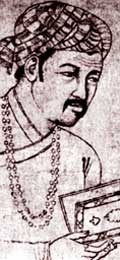|
|
| Portrait of an era |
The Miniaturist By Kunal Basu, Penguin, Rs 250
Kunal Basu’s second novel, The Miniaturist, blends history and fiction to recreate the world of 16th century India through the story of Bihzad, the illiterate yet exceptionally talented painter in the court of Akbar. The book provides remarkable insights into the Mughal world — a world where one’s identity is conferred by fealty to the emperor, where art itself is manufactured to pay obeisance to him. The cry “Allahu Akbar”, which declares god’s greatness and simultaneously equates Akbar with god, resounds through the pages of the novel as we are taken on Bihzad’s journey through court intrigue, fame, expulsion and final forgiveness.
Akbar’s empire is evocatively presented through the busy world at the factory of art — the kitabkhana — where miniature paintings flattering the king are churned out by the thousand. Characters like the khwaja, Bihzad’s father who encourages his potential; the stern daroga who is intermediary between the court and the art workshop; the garrulous paintseller, Salim Amiri; the famous art teacher, Mir Sayyid Ali add colour to the novel while shaping Bihzad’s formative years. The anxious wait for the emperor’s favour, the transition from Agra to Fatehpur Sikri, rivalry among artists, their drunken revelry — all add richness to the historical imagination.
The sexuality portrayed in the novel is uninhibited, yet confined to physical gratification alone. The slave girls on sale at the bazaar or the women of Hazari Lal’s harem have no identity beyond their bodies which are marketable commodities. Bihzad addictively visits the whorehouse, as did his father, sleeps with his stepmother Zuleikha and lusts for the sadistically sensual Zuhra, who, in turn, busies herself with a young boy.
Despite their abundance, the physical relationships remain strangely flat and mechanical. Bihzad’s true love is not any of those with whom he shares a carnal relationship, but the one he reveres and cannot touch. The artist’s muse is the emperor. Secretly painting his fantasies of Akbar as a lover constitutes Bihzad’s crime, an unpardonable one in the Mughal era.
This leads to the novel’s essential questioning of the true meaning of art. Different theories are posited — painting is seen as representing the world in its original beauty, just as god intended it; it is seen as hopelessly ineffectual, being unable to create, only able to replicate life; as a means of coming close to god and as a crippling curse.
The focus is on art as being non-conformist. The novel reveals that inspiration does not heed manmade boundaries. Bihzad’s genius flouts all such barriers, for he can both give shape to the Portrait of the Lady, which is worshipped as divine, and can presume, through his art, to enter into prohibited homosexual encounters with the emperor. Bihzad’s ultimate realization is that art is endemic to his soul, whether he lives as a court favourite or an outcast.
The second half of the novel concentrates on Bihzad’s expulsion from Hindustan, his unlikely friendship with the eunuch Hilal Khan and marriage to Zuhra. The tribulations continue with Bihzad’s self-inflicted blindness and eventual beggary. But his struggles to achieve liberation as a painter culminate in the last section with his final inspired portrait of Akbar on his deathbed.
The Miniaturist is much like the paintings it describes — carefully crafted with lavish details of the Mughal era. The book has a self-conscious design, exemplified, for instance, by the beginning of each section of the novel with an Indian quote — Naqsh (patterns), Tarkh (shape), Tasveer (portrait). Imposing this definite pattern of arrangement aligns the author’s representation of Bihzad’s story with Bihzad’s art.











